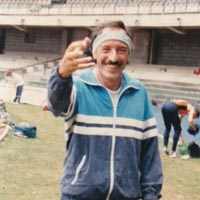Paolo Gava, a professional engineer, who has become a Master athlete, an amateur scientist and a lifelong friend

HTML: 2
All claims expressed in this article are solely those of the authors and do not necessarily represent those of their affiliated organizations, or those of the publisher, the editors and the reviewers. Any product that may be evaluated in this article or claim that may be made by its manufacturer is not guaranteed or endorsed by the publisher.
Paolo Gava, (Conegliano, Treviso, September 1, 1946 – Stra, Venezia, Italy, July 19, 2021) was a sustainable resources engineer, who worked in Italy, France and England, leading research programs well before the current international interest in countering global warming. Passionate about Tango, Paolo kept himself in shape for many decades by running or pedaling or roller-skating, after years of training as a semi-professional athlete, competing and winning Italian and European short distance races in the Master classes. Then, Paolo applied his engineering skills to optimize comparisons between the results of the different Classes of Master Athletes, questioning the rules used by Italian and World Master Sports Associations. Friendly discussing during an after-dinner, he shocked us claiming that, in absence of diseases and trauma (Early Aging), the aging decay is a linear process from 30 to 110 years. Under our friendly pressure he was able to publish his first biomedical article, detailing his mathematical approaches and results in a 2015 issue of Experimental Aging Research, titled: Age-associated power decline from running, jumping and throwing male master world records. To honor his other legacies during his last six years of life, we add here further examples of Paolo's scientific studies and his relationships with senior colleagues and young students of sports and aging sciences.
Gava P, Kern H, Carraro U. Age-associated power decline from running, jumping, and throwing male masters world records. Exp Aging Res. 2015;41(2):115-35. DOI: https://doi.org/10.1080/0361073X.2015.1001648
Carraro U, Kern H, Gava P, Hofer C, Loefler S, Gargiulo P, Mosole S, Zampieri S, Gobbo V, Ravara B, Piccione F, Marcante A, Baba A, Schils S, Pond A, Gava F. Biology of Muscle Atrophy and of its Recovery by FES in Aging and Mobility Impairments: Roots and By-Products. Eur J Transl Myol. 2015 Aug 25;25(4):221-30. DOI: https://doi.org/10.4081/ejtm.2015.5272
Carraro U, Kern H, Gava P, Hofer C, Loefler S, Gargiulo P, Edmunds K, Árnadóttir ÍD, Zampieri S, Ravara B, Gava F, Nori A, Gobbo V, Masiero S, Marcante A, Baba A, Piccione F, Schils S, Pond A, Mosole S. Recovery from muscle weakness by exercise and FES: lessons from Masters, active or sedentary seniors and SCI patients. Aging Clin Exp Res. 2017 Aug;29(4):579-590. Epub 2016 Sep 3. DOI: https://doi.org/10.1007/s40520-016-0619-1
Gava P, Giuriati W, Ravara B. Gender difference of aging performance decay rate in normalized Masters World Records of Athletics: much less than expected. Eur J Transl Myol. 2020 Apr 1;30(1):8869. DOI: https://doi.org/10.4081/ejtm.2019.8869
Zuccon D. Analisi della partecipazione e della prestazione di atleti senior machili e femminili in diverse edizioni della Venicemarathon. University of Padova. Thesis in Sport Sciences (Italian with English summary).
Timing Data Service: https://tds.sport/it
Stones MJ. Age Differences, Age Changes, and Generalizability in Marathon Running by Master Athletes. Front Psychol. 2019 Sep 20;10:2161. DOI: https://doi.org/10.3389/fpsyg.2019.02161
Running USA. Available online: https://www.runningusa.org// (accessed on 15 February 2019)
Anthony D. Differences in Participation and Performance Trends in Age Group Half and Full Marathoners. Chin. J. Physiol. 2015, 57, 209-219 DOI: https://doi.org/10.4077/CJP.2014.BAC219
Nikolaidis PT, Cuk I, Rosemann T, Knechtle B. Performance and Pacing of Age Groups in Half-Marathon and Marathon. Int J Environ Res Public Health. 2019 May 20;16(10):1777. DOI: https://doi.org/10.3390/ijerph16101777
Leyk D, Erley O, Gorges W, Ridder D, Rüther T, Wunderlich M, Sievert A, Essfeld D, Piekarski C, Erren T. Performance, training and lifestyle parameters of marathon runners aged 20-80 years: results of the PACE-study. Int J Sports Med. 2009 May;30(5):360-5. DOI: https://doi.org/10.1055/s-0028-1105935
Marzetti E, Calvani R, Tosato M, Cesari M, Di Bari M, Cherubini A, Broccatelli M, Savera G, D'Elia M, Pahor M, Bernabei R, Landi F; SPRINTT Consortium. Physical activity and exercise as countermeasures to physical frailty and sarcopenia. Aging Clin Exp Res. 2017 Feb;29(1):35-42. Epub 2017 Feb 8. DOI: https://doi.org/10.1007/s40520-016-0705-4
Albertin G, Astolfi L, Falda M, Zuccon D, Ravara B, Kern H, Ferrante G, De Caro R, Guidolin D. From 2003 to 2019 the participation in the Venice Marathon of female Master Athletes continued to increase. Eur J Transl Myol. 31 (4): 10266, 2021.
PAGEPress has chosen to apply the Creative Commons Attribution NonCommercial 4.0 International License (CC BY-NC 4.0) to all manuscripts to be published.


 https://doi.org/10.4081/ejtm.2021.10260
https://doi.org/10.4081/ejtm.2021.10260



